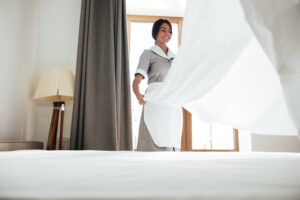How can Hotels Improve Safety?
Hotel employees often work alone and work late hours and consequently they are vulnerable to sexual assaults and workplace violence. 58% of hotel workers disclosed that they have been sexually harassed or assaulted during the course of their work. Many states and cities have passed hotel panic button laws requiring that hotel employees be equipped with panic buttons as a safety measure. Major hotel brands such as Marriott, Hilton, Hyatt and IHG have also been focusing on employee safety and require their properties to become compliant with panic button requirements by 2023. Hotels need to act quickly in order to meet the various panic button deadlines and to ensure the safety of their most vulnerable employees. A 2016 report conducted by United Here found that hotel employees are often subjected to harassment and inappropriate behaviors by guests.
The report uncovered the following:
- Over 45% of employees have been subjected to indecent exposure (guests were naked when they answered the door, exposed themselves, or flashed)
- Over 20% experienced unwanted sexually suggestive looks or gestures
- Over 15% experienced unwelcome sexual comment, jokes or questions
- 15% of employees have been cornered by guests
- 10% have been subjected to unwanted touching (kissing, grabbing, pinching, patting, groping)
- More than 10% have been pressured for a date or sexual favors
What are Some of the Safety Challenges Facing the Hospitality Industry?
- Housekeepers often work alone and are separated from their team members, as a result they are vulnerable to sexual assaults and harassment.
- Staff turnover rates in Hospitality is significantly higher than in other industries and rates now slightly exceed pre-pandemic levels. Room attendant turnover is now over 103% annually.
- The Hospitality Industry is experiencing a major labor shortage and hotels need to find ways to attract employees.
- Hotel personnel need to monitor all areas of the hotel in order to increase safety.
How Can Hotels Improve safety?
- Providing employees with hotel panic buttons can help them to be connected to their teams and provides team members and security personnel with precise locations during an emergency.
- In addition to providing panic buttons, the AHLA’s 5-Star Promise require participating hotels to provide regular training in order to increase the safety of their workers.
- Investing in panic buttons will help hotels to attract more candidates, by offering prospective employees a safe work environment.
- Hotels that invest in the safety of employees by providing hotel panic buttons will create a safer work environment and employees are more likely to stay with hotels where they feel safe and supported.
- Hotel staff can use panic buttons to report suspicious behavior or medical emergencies on the hotel’s premises.
- Notifying guests that panic buttons are in use can help to deter inappropriate behavior.
Hotels that Invested in Panic Buttons Reported that:
- Panic button devices offered reassurance that helpful resources are being deployed to accurate locations.
- Panic buttons improved communication between team members.
- Panic buttons offered an extra layer of security and peace of mind.
- The hotel panic button implementation process was seamless, and training was clear and simple.
- Panic button devices integrated well with the hotel’s existing technology.
- Panic button devices met budgetary needs.
Hotel Panic Button Requirements
Numerous cities and states have passed hotel panic button laws and have set specific guidelines as to what constitutes as a panic button device. Major hotels brands have also specified panic button requirements that their properties are required to adhere to. Panic button devices should have the ability to provide precise location information down to the exact floor and room number and as the location changes, panic button devices should send updates in real time. This will allow responders to locate the distressed employee within seconds or minutes of an emergency alert.
Hotel Panic Buttons should provide:
- Reliable geolocation capability with the ability to locate employees down to room-level accuracy.
- Panic button devices should consistently work in all locations, including guest rooms, public restrooms and areas that require employees to be alone with guests.
- Panic button devices should be easily activated by a single action like a push, pull or tap. They must provide a sustained signal without delays caused by entering passwords or waiting for the system to turn on.
- Panic buttons should have the capability to dispatch responders immediately when an emergency alert is sent.
- Panic button devices should minimize unintentional activation and resist possible disabling by attackers.
Panic Buttons vs Noise Makers
Panic buttons or noise makers, which device is most effective at keeping employees safe? Some hotels have opted to purchase noise makers, which are devices that when pressed emit an ear-piercing sound. Although noise makers are extremely inexpensive when compared to other devices, they do not alert hotel security personnel or give the location of the employee in distress and the sound emitted can be drowned out by television or cleaning equipment noise.
Noise Maker Disadvantages
- Noise makers do not send emergency alerts or provide location details to hotel security personnel.
- Noise makers can be drowned out by television noise or cleaning equipment like vacuums.
- Building materials such as concrete floors and ceilings reduce sound by as much as 70 decibels.
- Drywall and other construction can also reduce sound by as much as 40 decimals.
When panic button devices are pressed, an emergency alert is sent out to designated hotel personnel and provides the location of the employee in distress, down to the precise floor and room number. Panic buttons are designed to send alerts in real time and if the employee in distress changes location, updates are continuously sent, allowing responders to locate the employee within seconds or minutes. Panic buttons can also be configured to alert designated hotel security personnel or emergency responders in the event of a medical emergency. Hotel panic button devices will continuously send out alerts until the issue has been resolved.
Hotel Panic Button Key Advantages
- Panic buttons can be configured to send emergency alerts to predetermined emergency contacts or to local authorities.
- Panic buttons transmit locations down to the precise floor and room number where the distress signal originated.
- Information is sent in real time and is updated if the employee in distress changes location.
- Panic button systems support two-way communication.




